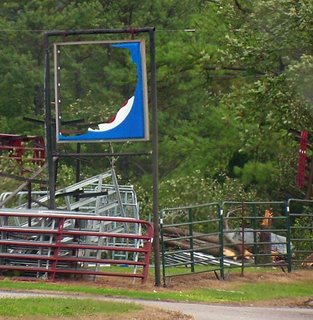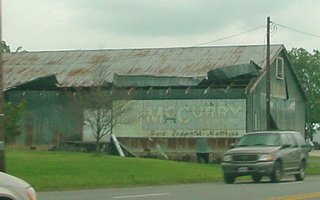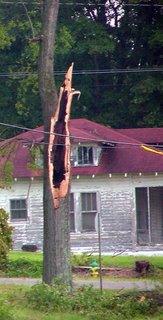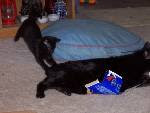Part III
"More To Go"
It was already lighter when we arrived at the notch. We watched headlamps from a party at the lower basin camp start up to Sahale or Sharkfin. (We never did see where they went.) We wondered if they had noticed our lights on the ridge and what they thought was going on.
Then Steve set about making himself comfortable and took a snooze. I was too uncomfortable to sleep at first and after jostling about in different positions finally took a nap. Steve said I even snored. I awoke a half hour later.

Nap time (photo by Steve Machuga)
Then we watched the sky turn beautiful colors as the sun rose. I ate a bag of dried fruit and nuts and Steve had a few granola bars. We weren't quite ready to get moving, so we lounged until the sun hit a feature we were calling "The Scottish Arete."
Having gotten some rest, we headed out slowly and methodically back down to camp. In our tired condition, we knew there would be a few cruxes on the way to camp. The first was getting around the chock stone at the top of the gully. This proved to be no issue and we were now making our way down the slabs and loose rock. We reached the bottom of the gully and got on the snow. Steve felt comfortable with a standing glissade. I put crampons on and walked quickly down the snow. (I just wasn't feeling confident in the boots I had chosen.)
We got back onto rock in the lower gully and navigated our way down to the next crux. On the way up we made an uncomfortable step onto the slab from a snow lip on the lower snowfield. I was sure there was no way to make this step after the previous day's melting. That would mean we would have a choice of climbing down either of two short waterfalls. When we arrived, Steve probed it out and made a step onto a lower portion of the final slab before making the big step out onto the snow. It didn't look that safe to me so I hesitated before finally making a large gentle step onto the snow. We crossed that short bit of snow and then gained the slabs again before jumping back onto snow down to camp.
Once in camp we quickly went about filtering water to drink. It was nice and cold snow melt and I drank enough to give me brain freeze. We lounged again at the stream dipping our feet in the water and dreading the coming hike out. After a while we made our way back to the tent to pack up and head out.
The flies were horrible at the tent and it made packing difficult. In my already weakened mental state the flies were the final straw. I was running about trying to kill any that came near me. It was an ordeal. We packed as quickly as possible and hoped that once we left the camp area we would be rid of the pesky insects.
Our hope faded as we had to negotiate a grassy moraine littered with Marmot dens and scat. The flies were even worse. There were brief moments hiking down the basin where there was a faint wind or even cooler temps and seemingly no flies. Then we would encounter another area, like the lower stream crossings and be swarmed again.
Once through the stream crossings we made it to the woods and through the avalanche debris fields. Constantly in and out of swarms of flies. At one point during the heaviest bushwhack area of the trail the flies were so thick I looked like Pig Pen from Peanuts with the swarm around me. Steve said he could see dozens landing all over his clothes. When we escaped that area, I told Steve I was close to a nervous breakdown. He said that me running down the trail screaming "Cannot stop! Must keep moving!" was a sign of a partial breakdown. I agreed and knew that the worst was behind us.
About 20 minutes later we were back at the car. We found a note from the rangers on the windshield stating "Steve and Gilbert: Your party has been reported passed due. Please check into the ranger station when you receive this note. A search party is being sent." We packed the car quickly and drank some more water before heading out.
The drive on Cascade River Road always seems longer than it should be. I understand that it is a 23 mile mostly dirt road with a 35mph speed limit, but it just seems to go on forever. Once out, we made right for the ranger station and reported in. We were told someone was just sent out to look for us and we presumed it was the ranger truck heading up the road as we came out. After leaving the ranger station we called our contacts to let them know we were alright. Apparently the rangers had gotten to that first in some cases. Then it was time for the long drive home.
This was another exciting experience in the mountains and was a good learning experience.
I think both Steve and I learned some lessons this weekend:
One of which is that the two of us actually get tired. (Which may be hard for others to believe.) I think if we had not done South Early Winter Spire on Saturday, the Forbidden trip would have played out completely different. We would have been fresh and moving faster without all the lethargic delays. I cannot say for sure this would have kept us on route during the climbing, but it probably would of had us moving faster on route, as well as the approach. It may also have made us more at ease with the rock quality and exposure.
Another lesson has to do with emergency contacts and when to call in a passed due. This was partially a flub because we had changed our plans a few times, so it wasn't exactly set in stone when we left Edmonds. That caused the timing to be off, and created a panic regarding our return time. In retrospect, it appears that Steve and I may not have even been on the same page regarding when authorities should be contacted. While Steve and I had no idea that a rescue was initiated, this incident has made me strongly consider the use of a Spot.
A funny thing about the "rescue" was that when we arrived at the ranger station the ranger behind the desk said they could have initiated the search earlier if we had used the climbing register. (We had neglected to, probably due to our fluid plans.) I thought at the time this was funny as I didn't even think the rescue needed to be initiated at all and that starting it earlier was a waste of time and resources.
The route itself was interesting. I don't know if I'd recommend it, as I was not a big fan of the rock quality. (Well, at least the quality of the protection.) It is also the sort of route people seek for the exposure, which is not a reason I usually seek out routes. There were only a few memorable climbing segments on the route, so it is also not a route to seek out if you want to get into some climbing. However, the setting is hard to beat with numerous 8000' peaks nearby and many small and a few large glaciers tucked here and there. I'd have to admit to loving downclimbing the ridge in the dark as well. It is truly spectacular to be on a beautiful mountain like Forbidden and watch the sun set, the stars rise, and eventually give way to the sun again. It was something we obviously didn't plan to do, but the trip was enriched because of it. It was a wonderful experience that I shall never forget.
I think I learned a few things about my ability to stay alert and focused after being up all of the night. (Partial thanks to Powerbar Gel with Caffeine.) I'll probably always look back on this trip fondly even though the result was not what Steve and I were looking for.
And Steve and I still have not done the West Ridge, so perhaps we'll have to go back for that and see if it lives up to the popularity.
Once again, pics are here.
































 Nap time (photo by Steve Machuga)
Nap time (photo by Steve Machuga)

 As you can see, we have "Pickles." Pickles is a Cascade Fox. And unless you're an insensitive brute, most people would consider him a very adorable little guy. The problem is, Pickles was so charming, that he attracted a lot of friends, and with those friends came problems. This week, Pickles had to be euthanized (i.e. shot) because he was seriously injured. The general feeling is that he was injured because he was fed by humans.
As you can see, we have "Pickles." Pickles is a Cascade Fox. And unless you're an insensitive brute, most people would consider him a very adorable little guy. The problem is, Pickles was so charming, that he attracted a lot of friends, and with those friends came problems. This week, Pickles had to be euthanized (i.e. shot) because he was seriously injured. The general feeling is that he was injured because he was fed by humans. "After consultation with two wildlife veterinarians, we decided that this animal did not have reasonable prospects for survival in the wild. The leg injury was severe and there was some indication that there was head injury as well. This Cascade fox was fed by people well prior to the injury (even after the injury). Fed animals like this one quickly found that hanging around the
"After consultation with two wildlife veterinarians, we decided that this animal did not have reasonable prospects for survival in the wild. The leg injury was severe and there was some indication that there was head injury as well. This Cascade fox was fed by people well prior to the injury (even after the injury). Fed animals like this one quickly found that hanging around the 
 Your most welcome letter received: I have marked my apointment book Aug. 2 and 3 - Irwin Joslin may come here today; I had to use these dates as I work five days a week and the weekend is open and free to entertain you and your family. I do hope you can arrange to be here on these dates as I can show you so many interesting things about your ancestors.
Your most welcome letter received: I have marked my apointment book Aug. 2 and 3 - Irwin Joslin may come here today; I had to use these dates as I work five days a week and the weekend is open and free to entertain you and your family. I do hope you can arrange to be here on these dates as I can show you so many interesting things about your ancestors.




